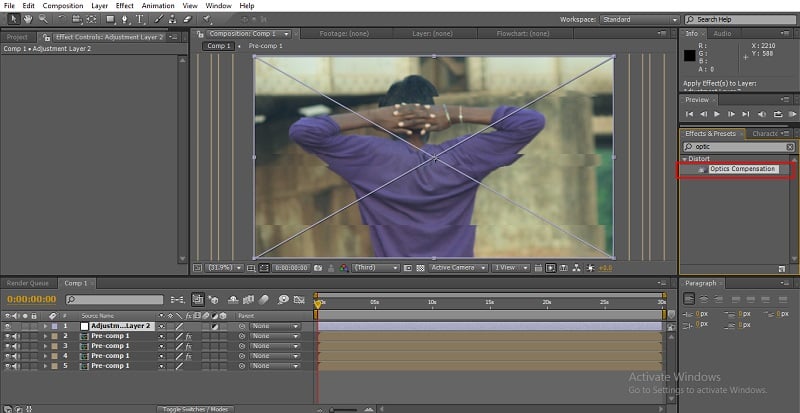
Offset + Optics Compensation Transition After Effects Tutorial AMVInstagram: VK: had to d. After Effects 2021 preview keeps freezing when I try to play it aenoiia.
Optics Compensation Using the Optics Compensation effect in After Effects will quickly rid your footage of any wide angle distortion issues. First, make sure you select Reverse Lens Distortion to turn it on. Next set the Field of View for the effect to 75. The Effect ' Optics Compensation ' in After Effects is great to compensate the distortion of certain lenses such as Fisheye lenses or wide angle, etc. I have only so far been able to replicate this in Blender by assigning my photo/video to a plane in the 3D space, aiming the.
Want to improve your video titles? Follow these eight easy tutorials for compositing techniques with Adobe After Effects.
At its core, After Effects is compositing software. But what exactly does compositing mean? Essentially, compositing is combining two or more video clips or pictures together, and making them look like they are part of the same scene. Often with compositing, the goal is to make everything appear natural, seamless, or organic.
The best compositing effects aren’t as complex as you might think. Simple effects like a blur and tint effect can make a world of difference. Let’s check out some compositing tips for After Effects!
If you want your video titles to look more professional, I recommend using some of the same compositing techniques used for Hollywood movie titles. These are subtle techniques that, when combined together, do a lot visually for your final look.
3D Lights
I’m a big advocate for lighting your text titles with 3D lights. This is because the 3D light will give your text a more natural falloff, visually similar to a gradient ramp. First, you will need make your text a 3D layer. (Check the cube icon for your text layer in the composition timeline.) Then create a Point light or a Spot light. Either light choice will work fine. You can now light your text using the 3D light (or multiple lights) and even create a title reveal animation by keyframing the light movement on the z-axis.
Gaussian Blur Effect
Next, you can soften your titles by applying the Gaussian Blur effect set to a low value. You can apply this directly to your text or on an adjustment layer above your titles. Now, you might ask, “why would I want to blur my sharp text? Isn’t sharper better?” It is a purely stylistic choice, which you can determine based on the mood of your project. Applying a subtle amount of blur to your titles will emulate a filmic look, while also reducing moire that might appear on the text edges.
Noise Effect
The Noise effect in After Effects has so many different uses. First, you can use the Noise effect to emulate the look of film grain on your titles. Create an adjustment layer above everything else in your composition, and then apply the Noise effect to it. Set the Amount of Noise between 3% and 10%, and I also recommend turning off the Use Color Noise setting. Secondly, the Noise effect is great at breaking up unwanted color banding that might occur on your titles or on the background layers.
Adding Chromatic Aberration on Titles
Creating chromatic aberration in After Effects requires a few steps to set up, but it is definitely worth it. Chromatic aberration is the color fringing you often see at the edges of blockbuster movie titles. Chromatic aberration is also a common visual occurrence with different camera lenses. Adding it in post to your titles or CGI elements can make composites look more rounded.
First, precompose your title text. (You may have to make that precomp a 3D layer again if the text was already a 3D layer.) Next, duplicate that precomposed title composition so that you have three total copies. Apply the Shift Channels effect to each title composition. Using the Shift Channels effect, we are basically splitting our title text into three RGB channels: one composition will be the red channel, one composition will be the green, and one will be the blue.
For the Red channel composition, set the “Take Red from” setting to Red. Set the other remaining settings to “Full off.” Also, set the composition blending mode to Screen. Repeat this for each composition, setting the “Take Color From” setting to the selected composition color and setting “Full off” on any channels that aren’t that same composition color.
Next, apply the Optics Compensation effect to any of the color channel compositions. Check on Reverse Lens Distortion, then adjust the Field of View setting. You should now be able to adjust the color fringing on your titles. Experiment with different variations.

I recommend only applying the Optics Compensation effect to one or two of the color channel compositions, and then make sure they have different Field of View values for the best results. My personal favorite is applying the Optics Compensation effect only to the Red color channel composition and setting the Field of View setting to 22.
Animating Space between Title Text
Optics Compensation After Effects Program
Frequently with title text, there will be some secondary movement with the text characters spacing apart. This is easy to do in After Effects, but the setting you need is somewhat hidden. On the text layer, toggle down the Text options, then select the Animate options. Select Tracking. This adds an Animator option to the text layer. From there, you can adjust the text Tracking Amount, which will evenly space out the characters on the title text. You’ll need to keyframe the Tracking Amount if you want the spacing to animate over time.
Optics Compensation Effect

The Optics Compensation effect can be used to emulate optical lens distortion on top of everything in your title sequence. It can often give the visual impression of zooming in or out, creating more depth. Apply the Optics Compensation effect to an Adjustment layer above the title text and any background elements. Check on Reverse Lens Distortion, then adjust the Field of View amount. Keyframe the Field of View if you want the optic distortion to animate over time.
Use 3D Lights on Background Layers
Just as we can use Point lights or Spot lights to light our title text, you can also use them to create more natural-looking backgrounds. Create a Solid and then make it a 3D layer. Then create a 3D light. For backgrounds I recommend using a Spot light, as it will give you more options to adjust. Experiment with the light’s cone angle and shadow feather settings.
Use 3D Lights on Alpha Channel Footage Elements
If you have any alpha channel footage elements in your title scene, such as dust particles, you can also cast colored lighting on those elements as well. Make your alpha channel footage element a 3D layer. Any 3D lights you already have in your scene will illuminate the alpha channel footage element. This can help make your composite of the alpha channel footage elements look more realistic. This works with lights of any color, and you can adjust a lights color in the light layer settings.
Optics Compensation After Effects Theory
More After Effects Compositing Tips
If you are looking for some more compositing tips, check out this tutorial which shows how to use effects like Lumetri Color and Camera Lens Blur for more realistic object composites.
Want more After Effects tutorials? Check these out.
Sign In
Register
- Access to orders in your account history
- Ability to add projects to a Favorites list
- Fast checkout with saved credit cards
- Personalized order invoices
Create Account
